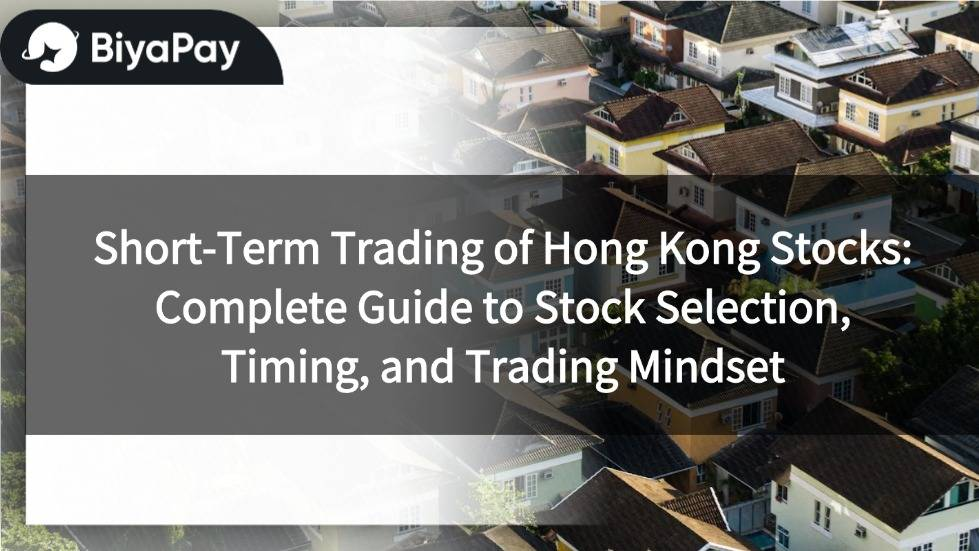- EasyCard
- Trade
- Help
- Announcement
- Academy
- SWIFT Code
- Iban Number
- Referral
- Customer Service
- Blog
- Creator
Short-Term Trading of Hong Kong Stocks: Complete Guide to Stock Selection, Timing, and Trading Mindset

Image Source: pexels
When engaging in short-term trading of Hong Kong stocks, the most important factors are stock selection, trading timing, and trading mindset. Short-term trading carries significantly higher risks than long-term trading. If you lack strict stop-loss, take-profit, and position control measures, losses can easily escalate due to the volatility of Hong Kong stock trends.
Many people, influenced by emotions, tend to overtrade or chase highs blindly, and these behaviors directly impact your success or failure. You can reflect on the challenges you face in stock selection, timing judgment, or mindset management to improve your skills in a targeted manner.
Key Points
-
The focus of short-term trading of Hong Kong stocks is selecting stocks with high volatility and active trading volume, combined with trending themes and fund flows, to increase trading opportunities.
-
Use multiple technical indicators and chart patterns to determine trading timing, adopt fast-in-fast-out and batch trading strategies to control risks.
-
Strictly execute take-profit and stop-loss rules and allocate positions reasonably to maintain trading discipline and avoid emotional decision-making.
-
Continuously learn and document trading experiences to optimize strategies and improve the stability and success rate of short-term trading.
-
Closely monitor Hong Kong stock market trends, flexibly adjust stock selection and trading strategies, and maintain rational judgment to handle market volatility.
Basics and Misconceptions
Definition of Short-Term Trading
Short-term trading refers to holding stocks for a very short period, typically 2 to 3 days, and no longer than 1 to 2 weeks. Your primary goal is to capture short-term price fluctuations and profit from rapid market changes. During short-term trading, you use technical analysis tools, such as gaps, fractals, and moving averages, to determine entry and exit timing. You should also learn to switch between different timeframes (e.g., 5-minute, daily, weekly) to reduce misjudgments caused by a single signal.
Common Misconceptions
Many beginners make mistakes when engaging in short-term trading. Below are common misconceptions:
- You may overly rely on a single technical indicator, ignoring overall market trends.
- You continue frequent trading during market consolidation or unclear trends, increasing risks.
- You ignore stop-loss measures, refusing to admit defeat when stock prices fall, leading to amplified losses.
- You blindly follow trends, chasing hot stocks without proper risk management.
- You fail to reserve sufficient funds for unexpected situations or over-leverage with margin, further increasing risks.
Tip: Short-term trading requires fast-in-fast-out strategies, selecting actively traded leading stocks, and flexibly adjusting positions based on price trends.
Risk Warning
Short-term trading carries high risks. You must assess your risk tolerance and avoid overlooking potential losses for short-term gains. During significant market volatility, incorrect directional judgments can lead to substantial losses. For example, when U.S. non-farm payroll data is released, Hong Kong stocks may experience sharp fluctuations. If you trade emotionally without setting stop-losses or chase orders, risks amplify further. You should remain rational, accept losses, and learn from them. Remember, investments involve risks, past performance does not guarantee future results, and this article’s content is for reference only and does not constitute investment advice.
Stock Selection Techniques

Image Source: unsplash
Volatility Selection
When engaging in short-term trading of Hong Kong stocks, you should prioritize stocks with high volatility. These stocks have larger daily price swings, offering more short-term trading opportunities. You can observe the price range over the past 5 to 10 days to select stocks with significant intraday high-low gaps. High volatility indicates greater market attention and active fund flows, making it easier to form clear buy and sell signals. You can also use technical indicators like Average True Range (ATR) to filter stocks with high volatility.
Tip: High volatility does not guarantee profits; you must combine trading volume and technical analysis to avoid entering or exiting during low-volume rises or falls.
Trending Themes
You should pay attention to trending market themes and sector rotations. At different times, the market has different hotspots, such as technology, pharmaceuticals, or new energy. You can judge which sectors are most popular based on news, brokerage reports, or fund flow directions. According to Yuan Zhifeng’s column, southbound funds have been reducing holdings in popular tech stocks like Tencent and Alibaba for multiple consecutive days, suggesting short-term investors reduce holdings moderately, indicating that fund flows significantly impact short-term performance. Some trending sectors, like pharmaceutical stocks (e.g., CSPC Pharmaceutical, WuXi Biologics, Hansoh Pharmaceutical), show strong performance, reflecting the influence of trending themes on short-term Hong Kong stock volatility. You can refer to the following methods:
- Track fund flows and select sectors with net fund inflows.
- Follow news hotspots to capture policy-supported or industry-favorable news.
- Combine technical indicators with thematic stock selection to improve success rates.
According to backtesting data from FinLab Financial Laboratory, clustering industries and combining individual stock fundamentals can effectively improve stock selection performance. Multi-industry strategies perform relatively stably in both bull and bear markets, with better resilience in bearish years. You can combine industry factors and individual stock conditions to select stocks with higher short-term opportunities.
Trading Volume
Trading volume is a key indicator for judging short-term opportunities. You should select stocks with active trading volume, as high volume indicates sufficient buying and selling forces, making it easier to form clear trends. You can observe the following points:
- If a surge in trading volume occurs at a staged top or significant resistance level, consider selling to avoid pullback risks.
- Sell immediately when a stock experiences a volume-driven sharp drop to avoid escalating losses.
- After consecutive volume-driven rises, shrinking volume may signal a short-term pullback.
- When a stock rises with high volume for multiple days, closely monitor subsequent volume changes, as declining volume may indicate a short-term pullback.
You can refer to theories by Larry Williams and Donald Cassidy, which suggest that trading volume changes provide important signals for short-term investment opportunities. You must closely monitor the interaction between trading volume and stock price to better seize short-term trading timing.
Hong Kong Stock Trends
You must constantly monitor Hong Kong stock trends, as the broader market direction directly impacts individual stock short-term performance. When the Hang Seng Index or major indices show clear trends, trading with the trend has a higher success rate. For example, when the Hang Seng Index falls 1.4% in a day, with 29 constituent stocks rising and 53 falling, popular tech stocks are broadly reduced, while some pharmaceutical stocks rise against the trend, indicating that fund flows in trending thematic stocks are closely tied to short-term price volatility. You can use the following methods to improve stock selection efficiency:
| Type | Characteristics | Short-Term Opportunities |
|---|---|---|
| Blue-Chip Stocks | High liquidity, lower volatility | Suitable for stable short-term trading |
| New Stocks | High volatility in early listing | High risk, high reward |
| Trending Stocks | Attracted by funds, active news | More short-term opportunities |
You can flexibly adjust your stock selection based on Hong Kong stock trends. For example, during strong market conditions, select leading stocks in trending sectors; during weak market conditions, consider stocks that resist declines. You should combine technical indicators, chart patterns, and market hotspots to improve short-term stock selection success rates.
Trading Timing

Image Source: pexels
Technical Analysis
When engaging in short-term trading of Hong Kong stocks, technical analysis is an indispensable tool. You can use indicators like MACD, RSI, and moving averages to help judge market trends and trading timing. MACD is a trend-following indicator, suitable for observing the direction and sustainability of Hong Kong stock trends. RSI is a contrarian indicator; when RSI is overbought, you can consider selling; when oversold, you can consider buying. These indicators are calculated based on past prices and trading volume, helping you simplify market information. However, you must understand that technical indicators only reflect past market conditions and cannot predict future trends with 100% accuracy. You should combine multiple indicators and Hong Kong stock trends with risk management to improve judgment accuracy.
According to research by technical analysis experts, MACD and RSI are widely used in market analysis. MACD is suitable for judging trends, while RSI is used to capture short-term reversals. You can directly see these indicators’ changes in trading software, enabling real-time decision-making. Although no definitive data proves these indicators are always accurate, practical experience shows that combining them with Hong Kong stock trends and other information can improve your trading success rate.
You can also select appropriate technical indicators based on different timeframes. Below are common indicator application scenarios:
| Timeframe | Indicator Type | Example Indicators |
|---|---|---|
| Long-Term Trend | Price Indicators | MA, MACD |
| Mid-Term Trend | Price Indicators | RSI, Bollinger Bands |
| Short-Term Trend | Price Indicators | KD, Stoch RSI |
You can flexibly choose indicator combinations based on your trading timeframe and closely monitor changes in Hong Kong stock trends.
Pattern Strategies
When engaging in short-term trading, you can use chart pattern strategies to capture trading opportunities. Common patterns include head and shoulders top, head and shoulders bottom, double top, and double bottom. These patterns provide reference signals for trend reversals or continuations. For example, a head and shoulders bottom typically signals a potential shift from a downtrend to an uptrend, while a head and shoulders top may indicate a shift from an uptrend to a downtrend. However, these patterns are not always accurate and can sometimes produce false breakouts, leading to misjudgments.
Books and real-world cases show that pattern strategies have successful examples in short-term trading, but failures also occur. You should use pattern signals as auxiliary tools and combine them with technical indicators and Hong Kong stock trends to confirm signal reliability. You can follow these practices:
- When a pattern appears, first observe whether trading volume aligns; signals are more reliable with increased volume.
- Combine MACD, RSI, and other indicators to strengthen judgment.
- Set stop-loss points to avoid losses from false breakouts.
Tip: Pattern strategies are suitable for short-term individual stock trading, but you must carefully evaluate signal authenticity and implement risk control.
Fast-In-Fast-Out
Short-term trading of Hong Kong stocks emphasizes fast-in-fast-out. You must learn to enter the market decisively when clear signals appear and exit immediately when the target price is reached or reversal signs emerge. This approach helps reduce holding risks and prevents losses from sudden market changes. You should follow the main direction of Hong Kong stock trends and avoid trading against the trend.
You can set clear entry and exit rules, such as buying on a MACD golden cross and considering selling when RSI exceeds 70. You can also use intraday charts to monitor short-term fluctuations and seize optimal timing. Waiting for opportunities is equally important; without clear signals, you should patiently observe and avoid frequent trading.
Note: Fast-in-fast-out requires high discipline and self-control; avoid chasing highs or cutting losses impulsively.
Batch Trading
When engaging in short-term trading, you can adopt a batch trading approach to flexibly handle market volatility. Batch trading helps diversify risks and reduces the pressure of entering or exiting at a single price. For example, you can divide your funds into three portions and buy or sell at different price levels. This way, even if your judgment is off, losses can be minimized.
Batch trading is particularly suitable when Hong Kong stock trends are highly volatile. When market direction is unclear, you can start with a small position and add more once the trend clarifies. You can also sell in batches when the stock price approaches the target price to lock in partial profits and avoid missing the best selling point.
- Batch entry: Reduces the risk of buying at a single price.
- Batch exit: Locks in profits in stages, reducing pullback pressure.
- Flexible adjustments: Adjust position sizes based on Hong Kong stock trend changes.
You should develop a batch trading strategy based on your capital size and risk tolerance to enhance short-term trading stability and confidence.
Mindset and Risk
Take-Profit and Stop-Loss
When engaging in short-term trading of Hong Kong stocks, you must strictly execute take-profit and stop-loss rules. This helps control risks and prevents significant losses due to market volatility or emotional influences. Many professional investors set clear profit and loss targets in advance and do not alter them arbitrarily. You can use limit orders to ensure take-profit and stop-loss execute at preset prices, reducing slippage risks. This approach makes your trading more stable and effectively controls losses.
Tip: After setting take-profit and stop-loss levels, stick to them and avoid missing optimal timing due to hesitation.
Position Management
You must allocate funds reasonably and control the position size for each trade. The investment in a single stock should not be too high to avoid significant losses from misjudgments. You can consider diversifying funds across different sectors or stocks to reduce overall risk. Some investors use derivatives like options to further hedge risks and improve capital efficiency.
Trading Discipline
Maintaining trading discipline is key to your success. You need to strictly follow your trading plan and avoid arbitrarily changing strategies. Research shows that trading discipline and risk control directly impact long-term performance. You can establish trading records and periodically review and optimize strategies to avoid detours and improve profit opportunities.
- Strictly follow stop-loss principles.
- Periodically review trading records.
- Continuously optimize trading strategies.
Emotional Control
You must learn to control emotions to avoid making wrong decisions due to fear or greed. Successful investors practice self-discipline and remain calm under pressure. You can learn psychological techniques to build a winning mindset. Remember, controlling yourself is more important than controlling the market; only a stable mindset ensures long-term survival in the market.
Practical Advice
Beginner Questions
When starting short-term trading of Hong Kong stocks, you may have many questions. How should you choose technical analysis tools? You can start learning with common indicators like MACD, RSI, and moving averages. What stock selection tools are available? You can use brokerage platform screeners to filter stocks based on trading volume, volatility, and trending sectors. How should you set stop-losses? You can set a stop-loss at 3% to 5% of your capital per trade based on your risk tolerance. Remember, no single tool suits everyone; you need to experiment to find the best approach for yourself.
Real-World Experience
You will encounter successes and failures in real-world trading. Below are specific cases:
- A trader named Colin entered the Bitcoin futures market with USD 2,000 and grew it to USD 6,000 in two weeks, a successful case.
- However, by canceling a stop-loss order, his USD 6,000 capital significantly dropped to USD 1,700, a failed experience.
- Colin learned the importance of risk control from this failure and continuously optimized his trading system.
- He uses technical analysis to determine entry points and adjusts strategies based on market conditions.
You can learn from these experiences that strictly executing stop-losses and continuously learning technical analysis are crucial.
Continuous Learning
You must continuously learn in short-term trading of Hong Kong stocks. You can read books, attend online courses, or join investment communities to share insights. You should establish your own trading records and periodically review each trade. You can try building a replicable trading system to enhance stability and confidence. Believe that only continuous learning and practice ensure long-term survival in the market.
You must remember that the key to success in short-term trading of Hong Kong stocks lies in stock selection, seizing trading timing, and managing your trading mindset. You should keep learning and continuously optimize your trading strategies. Professional books suggest that combining risk control, price action, and diverse data analysis can effectively improve short-term trading success rates. You must closely monitor Hong Kong stock trends and flexibly adjust strategies. Short-term trading carries high risks, so you must maintain discipline and risk awareness. It’s recommended to apply the techniques you learn in real-world trading, adjust based on your circumstances, and refer to market information while maintaining rational judgment.
FAQ
What is the optimal holding period for short-term trading of Hong Kong stocks?
You can choose to hold for 2 to 3 days, up to 1 to 2 weeks. This effectively captures short-term fluctuations and reduces market risks.
Tip: Avoid holding short-term positions for too long to prevent impacts from sudden news.
How can you quickly determine if a stock is suitable for short-term trading?
You can observe trading volume and volatility. Select stocks with active trading and high intraday volatility, as they are more suitable for short-term trading.
| Indicator | Recommended Value |
|---|---|
| Trading Volume | Above average |
| Intraday Volatility | Over 3% |
How much capital is needed to start short-term trading of Hong Kong stocks?
You can start with USD 1,000 (approximately HKD 7,800, based on 1 USD ≈ 7.8 HKD). More capital enhances risk diversification.
How do you set an effective stop-loss point?
You can set a stop-loss at 3% to 5% below the entry price. For example, if the entry price is USD 10, set the stop-loss at USD 9.5 to 9.7.
Note: Strictly execute stop-losses to avoid escalating losses.
How can beginners choose a suitable brokerage platform?
You can choose Hong Kong brokerages with good reputations, low fees, and stable trading systems, such as Phillip Securities or Bright Smart Securities, which are popular choices.
Mastering short-term Hong Kong stock trading demands precise stock selection, optimal timing, and disciplined risk management, but how can you ensure seamless fund flexibility to seize market opportunities? BiyaPay offers an all-in-one financial platform, enabling instant trading of US and Hong Kong stocks without offshore accounts, perfect for capitalizing on high-volatility stocks and trending sectors.
Real-time exchange rate tracking supports USD, HKD, and 30+ fiat and digital currencies, ensuring cost transparency, while global remittances to 190+ countries feature transfer fees as low as 0.5% with swift delivery, keeping your trading capital ready. A 5.48% annualized yield savings product maximizes idle funds, minimizing opportunity costs. Whether you’re chasing hot themes or executing rapid trades, sign up for BiyaPay today to boost trading efficiency and profitability!
*This article is provided for general information purposes and does not constitute legal, tax or other professional advice from BiyaPay or its subsidiaries and its affiliates, and it is not intended as a substitute for obtaining advice from a financial advisor or any other professional.
We make no representations, warranties or warranties, express or implied, as to the accuracy, completeness or timeliness of the contents of this publication.




Contact Us
Company and Team
BiyaPay Products
Customer Services
is a broker-dealer registered with the U.S. Securities and Exchange Commission (SEC) (No.: 802-127417), member of the Financial Industry Regulatory Authority (FINRA) (CRD: 325027), member of the Securities Investor Protection Corporation (SIPC), and regulated by FINRA and SEC.
registered with the US Financial Crimes Enforcement Network (FinCEN), as a Money Services Business (MSB), registration number: 31000218637349, and regulated by FinCEN.
registered as Financial Service Provider (FSP number: FSP1007221) in New Zealand, and is a member of the Financial Dispute Resolution Scheme, a New Zealand independent dispute resolution service provider.



















